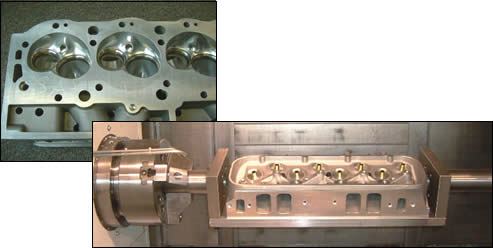Cylinder Head Porting On A Turn/Mill Machine
This complex milling operation is performed effectively on a machine that does turning.
Share




CNC milling is the machining that an automotive cylinder head is likely to require. Turning is not a capability you would look for in a machine tool meant to run such a part.
Indeed, when Mazak (Florence, Kentucky) first started to work on a better machining process for the benefit of a maker of high-performance heads, the machine tool company’s first attempt involved a five-axis machining center. But Robin Cave, national applications engineer for Mazak, says that a more capable and efficient process has now been developed for an Integrex machine.
“Integrex” is the company’s brand name for a family of CNC turn/mill machines. The term is traditionally associated with multitasking lathes.
However, the machine tool proving effective at cylinder head porting is no lathe, says Mr. Cave. It’s an “e”-series Integrex, and this distinction is significant. Earlier machines in the family have the slanting structure of a lathe, with the wedge-shaped work zone causing Y-axis travel to get progressively more limited toward the bottom of the machine. The e-series design gives the machine’s milling spindle the freedom to move like a machining center can move, with a box-shaped work zone permitting the same full field of travel at the machine’s top or bottom. The unit is still a turn/mill machine, but while the traditional Integrex might be thought of as a lathe effective for milling, the e-series version is essentially a machining center effective for turning.
The machine permits full five-axis milling. While B-axis motion comes from the tilting of the e-series machine’s spindle head, C-axis motion comes from the rotation of the horizontal spindle used for turning. The maker of cylinder heads does no turning on this machine, but instead uses this turning spindle exclusively in the five-axis mode. This direct-driven rotation does not involve a worm gear, unlike a previous process in which the company used indexers on vertical machining centers.
Related Content
-
WFL Milling Machines Feature Smart Sensors, Control System
M50 Millturn / 3,000 mm and M80X Millturn / 4,500 mm turning-boring-milling machines come equipped with a grinding attachment and a vibration-damped Silent ToolsTM Plus boring bar.
-
Grob Mill-Turn Machining Center Provides Flexible Performance
The G550T mill-turn universal machining center offers optimized milling and turning performance for a broad range of part materials in one setup.
-
How to Meet Aerospace’s Material Challenges and More at IMTS
Succeeding in aerospace manufacturing requires high-performing processes paired with high-performance machine tools. IMTS can help you find both.



























